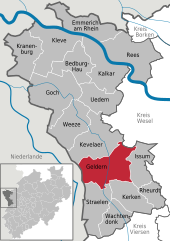Geldern
Geldern (Dutch: Gelderen, archaic English: Guelder(s)) is a city in the federal German state of North Rhine-Westphalia.
The first coat of arms of the city of Geldern was a shield with three medlars, referring to an event in the dragon legend.
In commemoration of this heroic feat, the Lords of Pont founded the city of Geldern at the confluence of the Niers and the Fleuth.
The probable ancestor of the Counts of Guelders was Gerhard Flamens, who received Wassenberg as a fief from Emperor Henry II in 1020.
The counts of Guelders moved their residence to the castle in Geldern, that was built probably around this date at the crossing of the Niers.
The castle and the accompanying medieval settlement were the origin of the present city, and also gave its name to the county and later duchy of Guelders.
During this period (more exactly between 1662 and 1664) Schloss Haag (first documented in 1337, located 1 km north of Geldern) was expanded.
At the end of the war, at the 1713 Treaty of Utrecht, the previously Spanish Upper Quarter of Guelders was divided between four powers: Austria, the United Provinces, Prussia and the Duchy of Jülich.
With the larger part of the former Upper Quarter, Geldern fell to Prussia and became the seat of administration of Prussian Guelders.
In World War II Geldern was bombed several times, at the end of 1944 and on 14 February 1945, which led to devastation in the city centre.
The parish church was also severely damaged, and the main building of Schloss Haag was completely destroyed.
The present composition of the city of Geldern was created at the territorial reorganization of North Rhine-Westphalia, on 1 July 1969.
60 km long cycle path along the Fossa Eugeniana, a never completed canal from the Rhine near Rheinberg to the Meuse near Venlo.
Geldern has the largest Whitsun(Pentecost) funfair of the lower Rhine, a street party in summer, and a Christmas Market.
The Deutsche Bahn railway station of Geldern lies on the line from Cleves to Düsseldorf via Krefeld.








